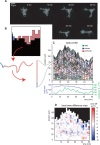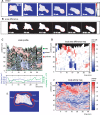Quantification of local morphodynamics and local GTPase activity by edge evolution tracking
- PMID: 19008941
- PMCID: PMC2573959
- DOI: 10.1371/journal.pcbi.1000223
Quantification of local morphodynamics and local GTPase activity by edge evolution tracking
Abstract
Advances in time-lapse fluorescence microscopy have enabled us to directly observe dynamic cellular phenomena. Although the techniques themselves have promoted the understanding of dynamic cellular functions, the vast number of images acquired has generated a need for automated processing tools to extract statistical information. A problem underlying the analysis of time-lapse cell images is the lack of rigorous methods to extract morphodynamic properties. Here, we propose an algorithm called edge evolution tracking (EET) to quantify the relationship between local morphological changes and local fluorescence intensities around a cell edge using time-lapse microscopy images. This algorithm enables us to trace the local edge extension and contraction by defining subdivided edges and their corresponding positions in successive frames. Thus, this algorithm enables the investigation of cross-correlations between local morphological changes and local intensity of fluorescent signals by considering the time shifts. By applying EET to fluorescence resonance energy transfer images of the Rho-family GTPases Rac1, Cdc42, and RhoA, we examined the cross-correlation between the local area difference and GTPase activity. The calculated correlations changed with time-shifts as expected, but surprisingly, the peak of the correlation coefficients appeared with a 6-8 min time shift of morphological changes and preceded the Rac1 or Cdc42 activities. Our method enables the quantification of the dynamics of local morphological change and local protein activity and statistical investigation of the relationship between them by considering time shifts in the relationship. Thus, this algorithm extends the value of time-lapse imaging data to better understand dynamics of cellular function.
Conflict of interest statement
The authors have declared that no competing interests exist.
Figures









Similar articles
-
Spatio-temporal co-ordination of RhoA, Rac1 and Cdc42 activation during prototypical edge protrusion and retraction dynamics.Sci Rep. 2016 Feb 25;6:21901. doi: 10.1038/srep21901. Sci Rep. 2016. PMID: 26912264 Free PMC article.
-
Different roles of the small GTPases Rac1, Cdc42, and RhoG in CALEB/NGC-induced dendritic tree complexity.J Neurochem. 2016 Oct;139(1):26-39. doi: 10.1111/jnc.13735. Epub 2016 Aug 4. J Neurochem. 2016. PMID: 27412363
-
Characterization of TCL, a new GTPase of the rho family related to TC10 andCcdc42.J Biol Chem. 2000 Nov 17;275(46):36457-64. doi: 10.1074/jbc.M003487200. J Biol Chem. 2000. PMID: 10967094
-
Regulation of the cytoskeleton and cell adhesion by the Rho family GTPases in mammalian cells.Annu Rev Biochem. 1999;68:459-86. doi: 10.1146/annurev.biochem.68.1.459. Annu Rev Biochem. 1999. PMID: 10872457 Review.
-
[The Rho protein family and its role in the cellular cytoskeleton].Postepy Hig Med Dosw (Online). 2008 Mar 10;62:110-7. Postepy Hig Med Dosw (Online). 2008. PMID: 18334926 Review. Polish.
Cited by
-
Profiling cellular morphodynamics by spatiotemporal spectrum decomposition.PLoS Comput Biol. 2018 Aug 2;14(8):e1006321. doi: 10.1371/journal.pcbi.1006321. eCollection 2018 Aug. PLoS Comput Biol. 2018. PMID: 30071020 Free PMC article.
-
Time series modeling of live-cell shape dynamics for image-based phenotypic profiling.Integr Biol (Camb). 2016 Jan;8(1):73-90. doi: 10.1039/c5ib00283d. Epub 2015 Dec 11. Integr Biol (Camb). 2016. PMID: 26658688 Free PMC article.
-
Stochastic models of cell protrusion arising from spatiotemporal signaling and adhesion dynamics.Methods Cell Biol. 2012;110:223-41. doi: 10.1016/B978-0-12-388403-9.00009-6. Methods Cell Biol. 2012. PMID: 22482951 Free PMC article.
-
Automated characterization of cell shape changes during amoeboid motility by skeletonization.BMC Syst Biol. 2010 Mar 24;4:33. doi: 10.1186/1752-0509-4-33. BMC Syst Biol. 2010. PMID: 20334652 Free PMC article.
-
Biological Dynamics Markup Language (BDML): an open format for representing quantitative biological dynamics data.Bioinformatics. 2015 Apr 1;31(7):1044-52. doi: 10.1093/bioinformatics/btu767. Epub 2014 Nov 19. Bioinformatics. 2015. PMID: 25414366 Free PMC article.
References
-
- Lecuit T, Lenne PF. Cell surface mechanics and the control of cell shape, tissue patterns and morphogenesis. Nat Rev Mol Cell Biol. 2007;8:633–644. - PubMed
-
- Bakal C, Aach J, Church G, Perrimon N. Quantitative morphological signatures define local signaling networks regulating cell morphology. Science. 2007;316:1753–1756. - PubMed
Publication types
MeSH terms
Substances
LinkOut - more resources
Full Text Sources
Research Materials
Miscellaneous

